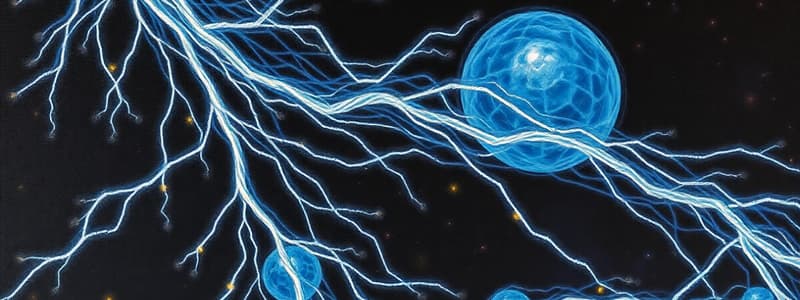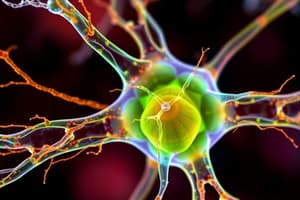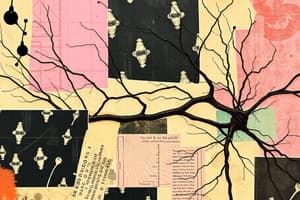Podcast
Questions and Answers
What role do CLASP proteins serve in relation to microtubules?
What role do CLASP proteins serve in relation to microtubules?
- They initiate microtubule catastrophe.
- They enhance microtubule disassembly.
- They rescue microtubules from catastrophe. (correct)
- They stabilize microtubules by preventing polymerization.
Where are the minus ends of microtubules typically anchored?
Where are the minus ends of microtubules typically anchored?
- At the nucleus.
- In the centrosome. (correct)
- In the cell membrane.
- At the cell periphery.
What distinctive feature do stable microtubules in nerve cells possess?
What distinctive feature do stable microtubules in nerve cells possess?
- They terminate in the cytoplasm rather than being anchored. (correct)
- They have orientation that varies in direction.
- They are anchored at both ends in the centrosome.
- They are exclusively formed during mitosis.
What is the primary direction of vesicle transport mediated by plus-end–directed kinesins?
What is the primary direction of vesicle transport mediated by plus-end–directed kinesins?
Which statement accurately describes the function of dynein and kinesin I?
Which statement accurately describes the function of dynein and kinesin I?
What is the primary role of the cytoskeleton in the context of cell movement?
What is the primary role of the cytoskeleton in the context of cell movement?
Which process indicates that GTP hydrolysis affects microtubule stability?
Which process indicates that GTP hydrolysis affects microtubule stability?
What occurs at the plus end of the microtubule during its growth phase?
What occurs at the plus end of the microtubule during its growth phase?
Which statement best describes the dynamic instability of microtubules?
Which statement best describes the dynamic instability of microtubules?
What is the effect of depolymerases on microtubules?
What is the effect of depolymerases on microtubules?
What structural component is unique to motile cilia compared to primary cilia?
What structural component is unique to motile cilia compared to primary cilia?
Which of the following components is responsible for the sliding motion of interpolar microtubules during anaphase B?
Which of the following components is responsible for the sliding motion of interpolar microtubules during anaphase B?
How are the outer microtubule doublets in cilia juxtaposed to the central pair of microtubules?
How are the outer microtubule doublets in cilia juxtaposed to the central pair of microtubules?
Which type of microtubule is directly responsible for attaching to kinetochores during cell division?
Which type of microtubule is directly responsible for attaching to kinetochores during cell division?
What mechanism drives chromosome movement towards the spindle poles during anaphase A?
What mechanism drives chromosome movement towards the spindle poles during anaphase A?
What is the primary role of astral microtubules in cell division?
What is the primary role of astral microtubules in cell division?
Which of the following correctly describes intermediate filaments (IFs)?
Which of the following correctly describes intermediate filaments (IFs)?
How do dynein and kinesin I differ in their functional directionality?
How do dynein and kinesin I differ in their functional directionality?
What type of cellular structure do desmosomes involve, and how do they relate to intermediate filaments?
What type of cellular structure do desmosomes involve, and how do they relate to intermediate filaments?
What is the structural assembly order of intermediate filaments starting from the polypeptide level?
What is the structural assembly order of intermediate filaments starting from the polypeptide level?
Flashcards
Microtubule Rescue
Microtubule Rescue
Proteins like CLASP rescue microtubules from catastrophe by stopping disassembly and restarting growth.
Centrosome Function
Centrosome Function
The centrosome is a microtubule organizing center (MTOC) where microtubule minus ends are anchored.
Microtubule Organization During Mitosis
Microtubule Organization During Mitosis
During mitosis, duplicated centrosomes separate and microtubules reorganize to form the mitotic spindle.
Microtubule Orientation in Axons and Dendrites
Microtubule Orientation in Axons and Dendrites
Signup and view all the flashcards
Microtubule Motor Proteins: Dynein and Kinesin I
Microtubule Motor Proteins: Dynein and Kinesin I
Signup and view all the flashcards
Cilia and Flagella
Cilia and Flagella
Signup and view all the flashcards
Mitotic Spindle
Mitotic Spindle
Signup and view all the flashcards
Kinetochore Microtubules
Kinetochore Microtubules
Signup and view all the flashcards
Interpolar Microtubules
Interpolar Microtubules
Signup and view all the flashcards
Astral Microtubules
Astral Microtubules
Signup and view all the flashcards
Intermediate Filaments
Intermediate Filaments
Signup and view all the flashcards
Desmosomal Cadherins
Desmosomal Cadherins
Signup and view all the flashcards
Hemidesmosomes
Hemidesmosomes
Signup and view all the flashcards
Plectin
Plectin
Signup and view all the flashcards
Keratin
Keratin
Signup and view all the flashcards
What is the structure of a microtubule?
What is the structure of a microtubule?
Signup and view all the flashcards
What is the role of GTP in microtubule polymerization?
What is the role of GTP in microtubule polymerization?
Signup and view all the flashcards
What is dynamic instability of microtubules?
What is dynamic instability of microtubules?
Signup and view all the flashcards
How do microtubule-associated proteins (MAPs) influence dynamic instability?
How do microtubule-associated proteins (MAPs) influence dynamic instability?
Signup and view all the flashcards
What are the key functions of microtubules in the cell?
What are the key functions of microtubules in the cell?
Signup and view all the flashcards
Study Notes
Cytoskeleton and Cell Motility
- The cytoskeleton is a dynamic scaffold providing structural support to the cell.
- It acts as a framework for positioning organelles.
- It's a network of tracks directing the movement of materials (organelles, vesicles, mRNA).
- It's involved in generating force for cell movement.
- The cytoskeleton is essential for cell division machinery.
- The cytoskeleton is composed of microfilaments, microtubules, and intermediate filaments.
Microtubules: Structure and Dynamic Instability
- Microtubules are hollow tubes made of tubulin dimers (α-tubulin and β-tubulin).
- Microtubules exhibit dynamic instability, alternating between growth and shrinkage phases.
- Microtubule growth is initiated by the addition of tubulin dimers to the plus end.
- GTP hydrolysis regulates microtubule stability; GTP-bound tubulin is more stable than GDP-bound tubulin.
- Microtubule-associated proteins (MAPs) regulate microtubule organization and stability.
- Polymerase increases the incorporation of GTP-bound tubulin.
- Depolymerases remove GTP-bound tubulin.
- CLASP proteins rescue microtubules from catastrophe.
Microtubule Organization
- Minus ends of microtubules are anchored in the centrosome (an MTOC).
- In interphase cells, the centrosome is located near the nucleus, and microtubules extend outward to the cell periphery.
- During mitosis, duplicated centrosomes separate and microtubules reorganize to form the mitotic spindle.
- Centrosomes consist of pericentriolar material surrounding a pair of centrioles. Microtubules radiate from this material.
Microtubule-Based Cilia and Flagella
- Cilia and flagella are microtubule-based structures involved in cell movement.
- Primary cilia and motile cilia are anchored in basal bodies, containing nine triplets of microtubules.
- The axoneme of motile cilia includes an additional central pair of microtubules, radial spokes, and dynein arms.
Microtubule Motor Proteins
- Dynein and kinesin move along microtubules in opposite directions.
- The globular head domains of the heavy chains bind microtubules, and serve as motor domains of the molecule.
- Light chains bind to cargo (e.g., vesicles).
Transport of Vesicles
- Kinesin I moves vesicles and organelles along microtubule plus ends, while dynein moves them along minus ends.
- The direction of transport corresponds to the direction of microtubule extension.
Association of Endoplasmic Reticulum
- The endoplasmic reticulum (ER) appears closely correlated with microtubules in epithelial cells.
Intermediate Filaments (IFs)
- IFs are flexible, rope-like fibers providing mechanical strength.
- IFs include keratin, desmin, vimentin, and lamins.
- IFs are a diverse family of proteins.
- IFs are crucial in providing support and resisting mechanical stress, especially in muscle cells, neurons, and epithelia.
Attachment to Desmosomes and Hemidesmosomes
- Desmosomes are cell-to-cell junctions involving intermediate filaments.
- Hemidesmosomes are cell-to-ECM junctions involving intermediate filaments.
Extracellular Matrix (ECM)
- The ECM has three main components: structural proteins (collagen), polysaccharides (GAGs and Proteoglycans), and adhesion proteins (fibronectin, laminin).
- The ECM plays a vital role in cells.
Collagen Structure and Function
- Collagen is a triple helix composed primarily of glycine, proline, and hydroxyproline
- Protein cross-links are crucial in the strength and stability of collagen.
- Type IV collagen is a key component of basal laminae
Type IV Collagen and Basal Lamina
- Type IV collagen forms networks, unlike other collagens which form fibrils.
- Crucial component of basal lamina.
Proteoglycans
- Proteoglycans are GAGs covalently linked to a core protein molecule.
Integrins
- Integrins are major receptors responsible for cell attachment to the ECM.
- Connect the ECM to the cytoskeletal filaments.
Cell-Matrix Junctions
- Integrins mediate focal adhesions and hemidesmosomes, crucial for cell attachment.
Functions of Cytoskeleton
- Golgi localization.
Studying That Suits You
Use AI to generate personalized quizzes and flashcards to suit your learning preferences.




